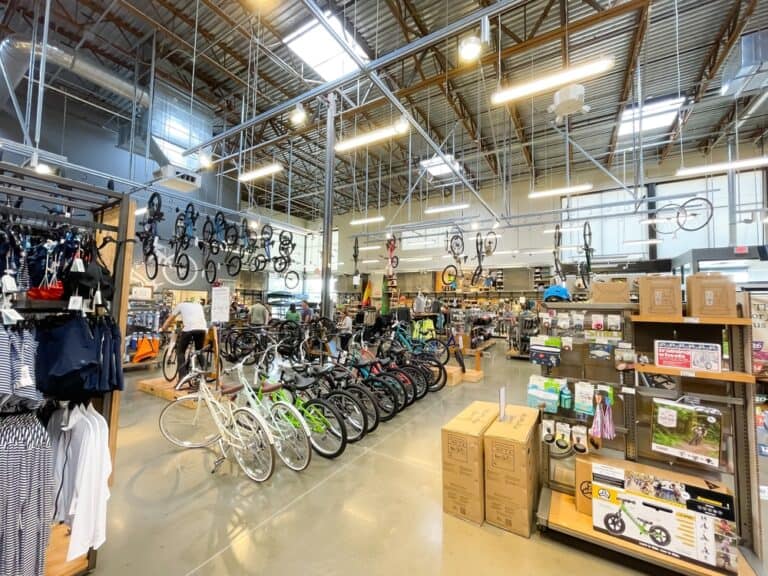Do BMX Bikes Have Brakes?

Editorial credit: Eddy Fahmi / Shutterstock.com
There are a few different types of BMX bikes that exist. Each of these different types of BMX bikes is manufactured slightly differently according to the purpose for which they are used. Due to each type of BMX bike serving a different purpose, in some cases, it is not always best for BMX bikes to have brakes.
For safety reasons, most BMX bikes come with pre-fitted brakes when newly purchased. Most BMX bikes come with a set of front and rear brakes; however, some BMX bikes require riders to have the ability to handlebar spins, and therefore they don’t have front brakes or riders choose to remove them.
There are different types of styles when it comes to riding BMX bikes. Some people use BMX bikes for racing, while others use BMX bikes for freestyle tricks. Depending on which style a rider has chosen to pursue affects how the brakes on their BMX bikes are configured.
The Reason Why Not All BMX Bikes Have Brakes
The reason why not all BMX bikes have brakes varies depending on the type of BMX rider you want to be. There are a few different types of BMX bikes, all of which are manufactured slightly differently according to which category they fall into. The three main categories of BMX bikes are BMX race bikes, freestyle BMX bikes, and flatland BMX bikes.
The Design Of Race BMX Bikes
Race BMX bikes are designed specifically for racing, meaning their design needs to be both lightweight and stable while ensuring the design is as strong as possible. For these reasons, the bike features rigid frames designed from steel, lightweight carbon, or aluminum.
The Use Of V-Brakes On Race BMX Bikes
Racing BMX bikes is exhilarating and fast-paced, and due to riders being so closely packed together on a closed circuit, it can be a hazardous sport should one of the riders on the circuit crash or lose control of their bike. For this reason, BMX racers are required to have a rear V brake that is very strong so that they can come to an abrupt stop should a crash occur on the circuit.
The Design Of Freestyle BMX Bikes
Freestyle BMX Bikes are designed to be optimal for performing different tricks. This is achieved by using smoother and thicker steel frames that can withstand knocks and abuse when riders are practicing new tricks they haven’t quite gotten the hang of yet.
Freestyle BMX bikes usually have brake mounts that you can remove, and some come with no brake mounts.
If you want to do freestyle BMX, you may choose to remove the brakes on your BMX bike entirely so you can perform certain tricks and maneuvers more efficiently. This, however, requires you, as the rider, to have a bit of a higher skill level when it comes to riding BMX, and removing both sets of brakes can be a safety hazard for more beginner riders.
Some freestyle BMX riders, however, choose to remove only the front set of brakes on their BMX bike. Removing only the front set of brakes is done by the rider to allow them to spin their front wheel around 180 or 360 degrees without the brake cable restricting their ability to do so or getting tangled.
If you don’t want to remove your BMX bike’s front brakes but still want to perform 360-degree handlebar spins, you should consider changing the configuration of the brakes on your BMX bike. By implementing a gyro brake design on your BMX bike, you will be able to have both front brakes and the ability to do handlebar spins with unrestricted movement.
The Use Of A Gyro Braking System On Freestyle BMX Bikes
A gyro braking system is used so that a BMX rider can have the luxury of having front brakes on their BMX bike without having the brake cable getting tangled or restricting movement while the rider is trying to perform tricks where they require their front wheel to be able to spin around up to 360 degrees.
A gyro braking system is implemented by running the front brake cable through the stem bolt of the BMX bike straight down from the handlebars and can be done on BMX bikes with both U, and V-shaped brakes. Routing the brake cables through the stem bolt of the bike allows them not to get tangled and, therefore, for the rider’s movement to be unrestricted when doing handlebar spins.
The Design Of Flatland BMX Bikes
Flatland BMX bikes are designed specifically for riders to do tricks at low speeds on a smooth surface and are not intended to jump, ramp, or grind like freestyle BMX bikes. Instead, they are designed for optimal weight distribution and maximum clearance.
Flatland BMX tricks involve balancing or spinning the bike in many different positions. For the BMX bike to get into these positions, plastic or grip-taped aluminum pegs are used for the rider to stand on to maneuver the bike. Unfortunately, maneuvering the bike into certain positions sometimes requires the handlebars to be spun, which could cause the brake cables to get tangled.
The Use Of U-Brakes On Flatland BMX Bikes
Most flatland BMX bikes make use of both front and rear U-brakes. For the brake cables not to get tangled on flatland BMX bikes, most of them use a brake cable detangler to prevent the brake cable from getting tangled around the bike’s frame when doing handlebar spins.
How To Stop On A BMX Without Using Brakes
As some BMX bikes do not have brakes, they must be stopped using a different method. Some methods developed include backpedaling, using your feet to drag along the ground, using your leg as a pivot to slide the bike out, and using your shoe on the back tire to slow down.
Pedaling Your Bike Backwards To Slow Down
Whether you have a trick bike or not, you may be able to pedal the bike backward. Should your bike be able to be pedaled backward, you can do this to slow down or come to a stop.
If you cannot backpedal your bike, you should consider using your feet as a means of braking. However, if you do decide to use your feet, it is essential to note that if you are traveling at a relatively high speed, using your feet can be a safety issue, and you have a chance of sustaining an injury to either your foot or ankle and, in some cases both.
Using Your Feet To Slow Down
You can use your feet to brake at slower speeds by placing both feet on the ground next to the sides of your bike while moving. By ensuring the bottom of your shoes is touching the ground while you are moving, friction is created between the soles of your shoes and the ground, which causes the bike to start slowing down.
Using Your Shoe To Slow Down The Rear Tire’s Rotation
Another method of braking using your feet is by placing the sole of your shoe on the back tire of your bike while you are moving to reduce the speed at which your back tire is rotating by using friction and therefore allow your bike to slow down.
Using Your Leg As A Pivot To Power Slide
Lastly, the rider can also slow down by sliding out the back tire of the bike deliberately. This can be achieved by leaning the bike at a steep angle and dragging your inside leg along the ground to act as a pivot. Once your leg is being dragged along the ground, you need to kick out the back tire to get it to lift from the surface, which forces the bike into a slide and come to a stop.
It is important to note that using any method to slow down besides backpedaling requires a certain amount of practice and skill to do it correctly. In addition, each of these methods is relatively dangerous to attempt for a beginner, especially when traveling at higher speeds. It is therefore recommended to keep the brakes on your BMX if you are a beginner for safety reasons.

Conclusion
As a safety precaution, most BMX bikes come with brakes. However, depending on what type of BMX bike you decide to purchase, the brake setup may differ as it may come with a gyro braking system, a removable brake mount, or only a rear brake, or sometimes it will come with no brakes at all.
Racing BMX bikes must have strong rear V-brakes as a safety precaution; however, brakes are not commonly used when racing BMX bikes. Freestyle BMX bikes tend to come with removable brake mounts or gyro braking systems so riders can do handlebar spins without tangling their brake cables. Flatland BMX bikes tend to come with U-brakes and often make use of a cable detangler.
References







